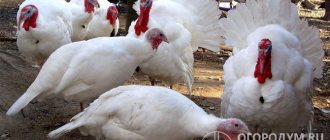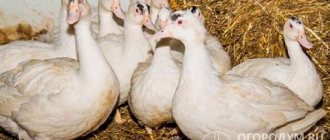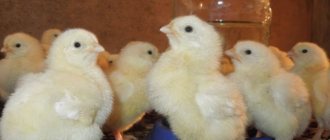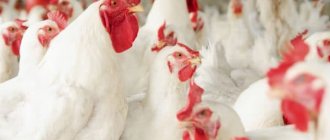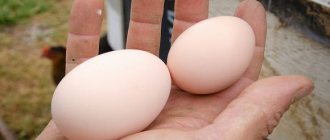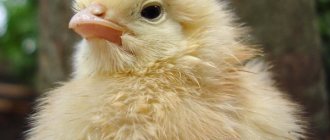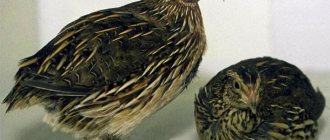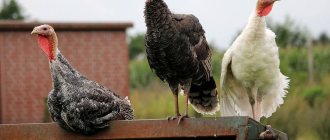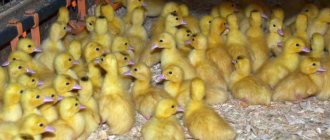Successful breeding of chickens of any kind depends on the correctly selected breed, living conditions, feeding, and personal desire to breed poultry. One of the most popular groups of breeds are chicken crosses. These are poultry hybrids obtained by crossing different breeds. Such a process is complex and is carried out only by specialists according to strictly established rules.
Crosses are made by crossing roosters of one breed with hens of another. On an industrial scale, population lines are usually crossed. This process differs from ordinary interbreeding in complexity. In this case, not only natural insemination is used, but also blood transfusion.
Getting a hybrid
When producing a cross of chickens, breeders rely on one or more traits that the resulting bird should have. This is the period of maturity, growth rate, egg production. New breeds are developed using two or three breeds. In the first case, breeders get a simple line of chickens, and when using three breeds, a synthetic one. When these two lines are crossed, hybrids are obtained.
This work is carried out in order to obtain productive offspring that are superior to their parents in terms of specified indicators.
What is a line
Within each chicken breed, breeders develop several lines with better qualities than the rest of the breed. Over time, the lines degenerate and the bird loses its productivity. To prevent this from happening, the lines are periodically crossed with each other, which makes it possible to preserve or restore the useful qualities of the animal.
Breeding egg crosses
All crosses of egg-laying chickens are divided according to the color of the eggshell into white and brown.
White hybrids are the result of crossing different lines of white Leghorns. Brown shells in chickens, in the appearance of which not only Leghorns, but also Rhode Island and other breeds took part. In this case, Leghorns pass on egg production to the resulting offspring, but the shade of the shell is lost.
Crosses of chickens, from which eggs with brown shells are obtained, are in great demand. This is due to the fact that the bird is not subject to much stress and is resistant to heat and cold.
"Siberian"
A highly productive meat cross, bred in 1999 by employees of the Siberian Research Institute. Several crosses of domestic selection (“Broiler-6”, “Smena”) were used as a gene pool in combination with the results of foreign selection (“Euribred”, “Ross”).
The resulting hybrid is perfectly adapted to cellular maintenance under production conditions. The bird quickly adapts to unfavorable environmental factors. It is characterized by a high level of safety - 98%.
The productivity of laying hens from the parent flock is about 130 offspring. The maximum period for raising broilers is up to 50 days. Taking into account the average daily gain of 38 g, by this time they will already weigh more than 2 kg. To gain 1 kg of muscle mass, chickens need 2.1 kg of feed.
Breeds of egg-laying chickens
The best are considered to be hybrid chicken breeds bred by foreign breeders. Among them are the following breeds.
White:
- "Loman-White";
- "High Line";
- "Dekalb White."
Brown:
- "Loman-Brown";
- "High Line Silver Brown";
- "Isa-Brown."
Domestic breeders also have extensive experience in producing crosses. Among the best breeds are:
- "Start-1";
- "Crystal-5";
- "Borki";
- "B-121";
- "Progress";
- "Volzhsky" and some others.
From one chicken of any of these breeds it is possible to get up to 330 eggs per year, that is, the bird will lay an egg every day, taking short breaks. Of course, to achieve such results, it is necessary to properly feed and maintain the bird. If you do not meet the maintenance requirements, the chicken will produce no more than eighty percent of the eggs genetically laid down. However, raising chickens at home for beginners of foreign breeds can become disastrous. This is due to the fact that at first the lack of knowledge takes its toll, and the cross does not survive. For beginners, domestic selection is more suitable: “Slobozhansky-3”, “Borki-Color”.
Egg breeds have many characteristics. Their main advantage is large eggs and excellent egg production, but despite this, they do not fatten well. To get a batch of young animals, an incubator is needed, since hybrids have practically no brooding instinct. However, with proper maintenance, egg laying begins by the age of five months. It is for this purpose that egg-crossed chickens are kept. Breeding these breeds for meat is unprofitable due to poor development.
General information
Man was familiar with chickens even before our era. Currently, there are about 180 different breeds. As for egg-laying chickens, they were bred for the purpose of producing eggs. Laying hens do not have a brooding instinct. They are small in size and you won’t be able to get a lot of meat from such a chicken. Mini chickens and eggs lay excellent eggs. All these breeds are quite active and require a large area for walking.
Regardless of which breed is chosen, egg-laying chickens have common characteristics:
- Quite light bones and low carcass weight.
- Wide and large wings, the tail has long feathers.
- Large comb and earlobes.
- High activity.
- Rapid puberty, many laying hens begin to lay eggs 25 days after birth.
- Lack of brooding instinct. Therefore, if you want to start breeding, you cannot do without an incubator.
- Quite a small amount of balanced food, especially rich in calcium and mineral supplements.
Meat chickens
When asking the question “what does cross chicken mean,” many assume that these are breeds of broilers for meat production. They are able to gain up to a kilogram of clean meat in just forty days. With proper feeding, no more than two kilograms of feed are consumed per bird.
Long-term raising of chickens at home for beginners and professionals requires theoretical knowledge.
Broilers should only be kept on the floor. This is the most advantageous placement of the bird. At the same time, they are in close quarters to accelerate muscle growth. However, domestic farms are adapted for raising birds in cages, and not for floor keeping. Especially for such conditions, breeds were bred that were adapted specifically for cellular maintenance. These include the improved Ross 308, as well as SK Rus-6. For domestic poultry farming, the KOBB-500 cross and some other breeds are used.
The meat direction differs from the egg direction due to its large mass and short legs. The bird has sparse plumage. Chickens begin laying eggs after six months of age. In a year, one bird can lay up to hundreds of eggs weighing about 70 grams. Despite all these qualities, meat crosses are distinguished by the fact that they hatch eggs well.
Content specifics
On farms, egg-laying chickens are usually kept on semi-free range. When organizing courtyards and enclosures, it is necessary to take into account the fact that representatives of such breeds are distinguished by the “grace” of their constitution and fly well. Therefore, the fencing of the walking area is made high. The house in which the birds live may not be heated (not every summer resident has the opportunity to build a heated chicken coop), but care must be taken to ensure that the birds are protected from dampness and drafts. The room is equipped with lamps, standard feeders and drinkers, as well as nests (one nest for 5-6 hens) and perches. It is important that there is always a flat container with clean ash in the chicken coop: birds love to “bathe” in it, getting rid of external parasites. Owners of dachas and village farmsteads rarely keep laying hens in cages. For such farms, the optimal option is considered to be a floor-based housing option using deep, permanent bedding based on peat, sawdust, shavings, hay or other similar materials.
When equipping a poultry house, many owners independently make the necessary devices from scrap materials (in the photo - nests from plastic buckets)
The diet of adult egg hens usually consists of whole or crushed grains, wet mash and greens. In the summer, poultry on farms are fed twice a day, since most of the day they are out for a walk. In winter, laying hens should receive food 3-4 times a day, preferably at the same time. In the cold season, the diet is supplemented with fresh vegetables (chopped carrots, pumpkin, zucchini, cabbage leaves), dried herbs (alfalfa, nettle, etc.), sprouted grains and ready-made vitamin and mineral supplements. It is very important to ensure that the feed contains a sufficient amount of animal protein, since its deficiency negatively affects the quality of the eggs.
Throughout the year, chickens are given chalk, crushed shell rock or bone meal: they contain calcium necessary for the formation of eggshells
Breeds of meat birds
Among the representatives of the meat cross, the following types are distinguished:
- "Cornish". The bird weighs 3-4 kilograms. Over the course of a year, she lays up to 110 eggs weighing up to sixty grams.
- "Brahma". Average weight 4-5 kilograms. Egg production averages one hundred eggs per year weighing up to 65 grams.
- COBB-500. The peculiarity of the breed is early maturity. By the fortieth day, the weight of the chicken reaches 2.5 kilograms.
The Leghorn, Lohmann, and Hubbard breeds are often found in households.
Noble beauties of the Sussexes
Individuals of this breed are distinguished by their elegant appearance.
Chickens with a characteristic pattern on the neck and tail attract attention with their grace. There are many color options for individuals: Colombian, fawn, white, lavender, porcelain, brown, etc.
Light Columbia Sussex
The most popular in Europe and Russia is Colombian. Representatives of this species are white with a dark “necklace” on the neck. The ends of the flight and tail feathers are also painted black.
Sussexes in the poultry house - photo
The main characteristics of the breed are as follows:
- weight – 2.4-2.7 kg (females), 3-4 kg (males);
- egg weight – 56-58 g;
- beginning of oviposition – 5th month of life;
- productivity – 170-190 pcs.
The Sussex breed is very precocious: with proper care, young animals gain slaughter weight at 100-120 days of life. The breed's egg production depends on the time of year: in winter, productivity drops significantly, so on large farms chickens are often slaughtered with the onset of cold weather.
Sussex chickens
Meat and egg crosses
By crossing different lines of birds, meat-egg crosses were obtained. They are distinguished by their large mass and high egg production. However, these data are slightly lower than for birds of purely meat and egg production.
Chickens of cross breeds develop quite quickly, like meat chickens. Already at five months, the bird begins laying eggs and can lay over two hundred eggs, weighing about 65 grams. The advantage of raising meat and egg breeds is that chickens have a well-developed brooding instinct.
Their advantages and disadvantages
The main advantages of crosses:
- Due to their compact build, the density of birds per meter can be significant.
- Broilers are generally unpretentious to their living conditions.
- Productivity indicators for egg and meat yield are high.
- The calm temperament of birds eliminates fights in the chicken coop.
The downside is that chicks must be restricted in their food intake at five weeks of age. Since at a high growth rate, the bones of chickens slowly become stronger, which can lead to some problems in the future.
Due to their high productivity, crosses are classified as universal avian species.
Some birds are demanding when it comes to temperature conditions. Only young animals should be sent for slaughter, since old chickens and roosters have coarse, dry meat. Chickens of some varieties should be limited in food so that they gain normal weight (excess weight creates a load on the bones, as a result of which they are poorly strengthened, and various diseases may appear).
The best meat and egg breeds
Among meat-egg crosses, the following breeds are considered the best:
- "Australorp." The weight of the bird is 2.7 and 3.5 kilograms. A chicken can lay up to 170 eggs weighing about 55 grams per year.
- "Adler silver". The weight of roosters is 3.5 kilograms, chickens - 2.6. Egg production – 180 eggs.
- "Necks." The weight of roosters is up to 2.5 kilograms, and chickens are half a kilo less. In a year, crosses are capable of laying about 150 eggs weighing about 60 grams.
- "Kuchinsky Jubilee". Roosters weigh almost four kilograms, and chickens weigh about three. In a year, a chicken can lay up to 180 eggs weighing 60 grams.
- "Rhode Island". The weight of roosters is up to 4 kilograms, and chickens – up to three. Egg production – up to 180 eggs per year.
- "Orlovskaya vociferous." The weight of a rooster is up to four kilograms, chickens – up to three. Egg production is about 100 eggs per year weighing up to 80 grams.
Breeds such as “Borki”, “Belorus-9”, “Lohmann” are often found on private farmsteads. These crosses are capable of producing up to three hundred eggs per year.
"Competitor-2"
A two-line cross, created by breed scientists in 1999. by crossing Cornish with Plymouth Rocks. The hybrid obtained as a result of selection made it possible to significantly reduce maintenance costs compared to the original lines (more than 12%). At the same time, the average individual is not inferior in weight to a four-line cross.
These chickens are characterized by increased productivity and excellent adaptability to various types of housing in farms of various sizes. At one and a half months of age, the weight of broilers exceeds 2.6 kg. The rate of feed consumption for live weight gain in the amount of 1 kg is up to 2 kg.
According to external features, “Competitor-2” has a medium-sized head with a leaf-shaped crest. The back is wide and elongated. The chest is deep set and wide. The bones are strong. The limbs are widely spaced, the muscles are developed. The plumage is white and dense.
Chicken coop
For a small family, having 10 birds is quite enough. You can keep ten chickens of different breeds in separate chicken coops.
Any chicken coop for 10 chickens must be warm. The minimum temperature that should be in the room is -2 degrees.
In order for chickens to lay eggs consistently, it is necessary to organize lighting in the chicken coop: provide windows and electric lamps.
Each breed has its own requirements for housing density. Broilers are kept in a room with a stocking density of no more than three chickens per square meter. Egg breeds do well at a density of four birds per square meter. When keeping chickens in winter, you can increase the stocking density to six birds. This way they can withstand the cold better.
Before you start building a chicken coop for 10 chickens, you need to choose a place where it will be located and make drawings of the structure. The height of the room should be such that a person can easily walk there without bending his head. The warm part of the chicken coop should be about 2.5 meters in area. The bird must take a walk. To do this, a canopy fenced with mesh is attached to the warm part. Its area should be about 3 square meters. m. A hole with a diameter of about 50 cm is made between the barn and the walker so that the birds can pass freely. Perches and nests are placed inside the chicken coop. Three nests are enough for ten chickens.
Chicken breeding business
You can raise chickens at home not only to meet your own needs, but also to make money from it. First of all, you should analyze the pros and cons. And only then open your own small home business. Breeding chickens in the initial stages only requires a lot of desire and start-up capital.
First, you should think about what crosses of chickens will be raised. In parallel with choosing a breed, you should start preparing all the necessary documents for legalizing your business. If you develop a business plan, you can receive a subsidy for farming.
The next step is to choose a place where you plan to keep the birds. If you plan to make a small profit, then you can organize a mini-farm on your personal yard, if its area is large enough. In other cases, you can rent a room or a plot of land.
Then the purchase of young stock is made and sales of the finished product are sought. When calculating your budget, you should take into account the costs of medicines, feed, and veterinary services. It is not profitable to constantly purchase young animals; it is much more profitable to hatch chickens from your own eggs. To do this, you will need to think about a place where young animals of different ages will be kept, and purchase an incubator.
If you follow the technologies for raising and feeding chickens, you can get a net profit of 50 thousand rubles from 50 chickens per year. If possible, it can be increased by selling not only eggs, but also young animals.
Raising chickens is an interesting and easy task. You can keep these birds not only for your own needs, but also sell their products at the market, in cafes, restaurants, and shops.
